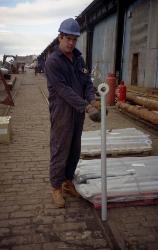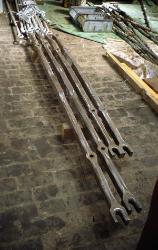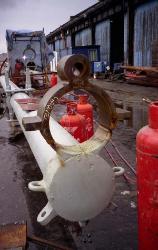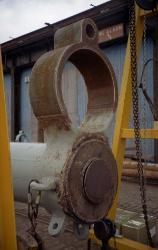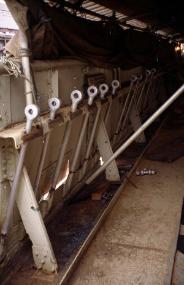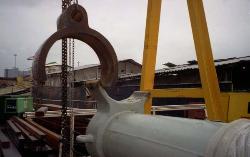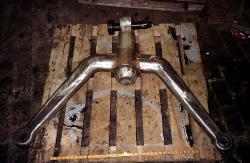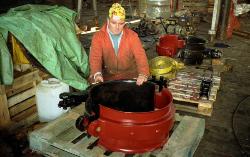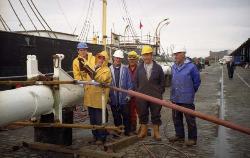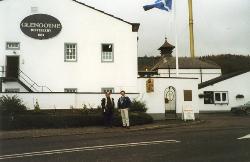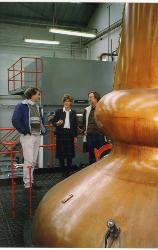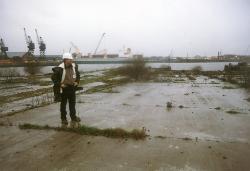

| Barque Glenlee 1896 |
| A photo essay of the rigging restoration of the 3 masted Barque Glenlee. Page 7 |
One of the new chainplates
Chainplates being installed. Finding the correct
angle both fore and aft as well as how far to angle
them inboard was one of the most difficult tasks. I
used the sail plan of the Galatea and a 10' lofting
string on a movable pillar on deck. This pillar
allowed me to visualise the angle the chainplate
must scribe. Remember there are no masts stepped
which would of made the whole exercise
rudimentary and simple
angle both fore and aft as well as how far to angle
them inboard was one of the most difficult tasks. I
used the sail plan of the Galatea and a 10' lofting
string on a movable pillar on deck. This pillar
allowed me to visualise the angle the chainplate
must scribe. Remember there are no masts stepped
which would of made the whole exercise
rudimentary and simple
New topmast cross tress for the main and
fore topmasts were flame cut from solid
stock
fore topmasts were flame cut from solid
stock
The new topmast cross trees being bent to
the correct swept aft angle. Only the
forward cross tree was swept aft. This
helped in increasing the bracing angle of
the topgallant yards.
the correct swept aft angle. Only the
forward cross tree was swept aft. This
helped in increasing the bracing angle of
the topgallant yards.
Quite a few "missing" pieces had to be
fabricated. Fortunately, we usually had at
least half of the missing item. The fore
truss bow, above, was flame cut on a
pattern taken off the original main truss
bow
fabricated. Fortunately, we usually had at
least half of the missing item. The fore
truss bow, above, was flame cut on a
pattern taken off the original main truss
bow
Fabricated after part of the fore and main
upper topsail parral buckets. The new
sections are primed and awaiting their final
coat of black paint.
upper topsail parral buckets. The new
sections are primed and awaiting their final
coat of black paint.
New fore and main topmast cap irons
being attached. The old cap irons had
been cut away during the rigging
down by the Spanish. The new cap
irons were flame cut from a solid billet
of steel. The work was impressive
and well done.
being attached. The old cap irons had
been cut away during the rigging
down by the Spanish. The new cap
irons were flame cut from a solid billet
of steel. The work was impressive
and well done.
Rigging is thirsty work and the occasional
break to visit one of the local sites was a
must. This is the Glengoyne distillery on
the outskirts of Glasgow and a fine drop it
is. My favorite distillery is Edradour,
located outside Pitlochery. Edradour is a
very fine single malt whisky and is worth
every effort to secure a bottle. It is the
smallest distillery in Scotland producing in
a year what The Glenlivet distills in a week.
break to visit one of the local sites was a
must. This is the Glengoyne distillery on
the outskirts of Glasgow and a fine drop it
is. My favorite distillery is Edradour,
located outside Pitlochery. Edradour is a
very fine single malt whisky and is worth
every effort to secure a bottle. It is the
smallest distillery in Scotland producing in
a year what The Glenlivet distills in a week.
Just down the river from Glenlee, was the
location of a shipyard very special to me and
all lovers of historic ships.
Gazing at the old ways at the closed down
Charles Connell & Co. Ltd. Yard, where the
ship Balclutha slid into the Clyde on 9
December 1886. I always felt very close to
the history of the river and could almost
image hearing the Song of the Clyde for a
moment.
location of a shipyard very special to me and
all lovers of historic ships.
Gazing at the old ways at the closed down
Charles Connell & Co. Ltd. Yard, where the
ship Balclutha slid into the Clyde on 9
December 1886. I always felt very close to
the history of the river and could almost
image hearing the Song of the Clyde for a
moment.
